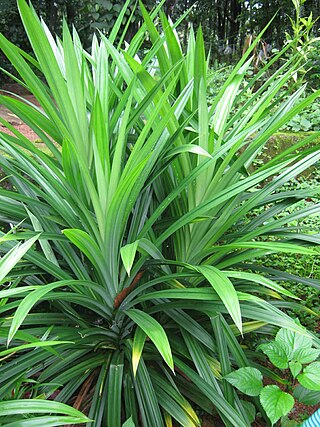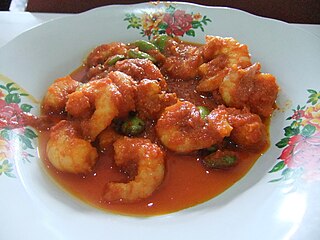
The bay leaf is an aromatic leaf commonly used as a herb in cooking. It can be used whole, either dried or fresh, in which case it is removed from the dish before consumption, or less commonly used in ground form. The flavor that a bay leaf imparts to a dish has not been universally agreed upon, but many agree it is a subtle addition.

Boesenbergia rotunda, commonly known as Chinese keys, fingerroot, lesser galangal or Chinese ginger, is a medicinal and culinary herb from China and Southeast Asia. In English, the root has traditionally been called fingerroot, because the shape of the rhizome resembles that of fingers growing out of a center piece.

Allspice, also known as Jamaica pepper, myrtle pepper, pimenta, or pimento, is the dried unripe berry of Pimenta dioica, a midcanopy tree native to the Greater Antilles, southern Mexico, and Central America, now cultivated in many warm parts of the world. The name allspice was coined as early as 1621 by the English, who valued it as a spice that combined the flavours of cinnamon, nutmeg, and clove. Contrary to common knowledge, it is not a mixture of spices.

Citrus hystrix, called the kaffir lime, Thai lime or makrut lime, is a citrus fruit native to tropical Southeast Asia.

Persicaria odorata, with common names Vietnamese coriander, rau răm, laksa leaf, Vietnamese cilantro, phak phai, praew leaf, hot mint, Cambodian mint and Vietnamese mint, is an herb whose leaves are used in Southeast Asian and Northeast Indian cooking.

Syzygium is a genus of flowering plants that belongs to the myrtle family, Myrtaceae. The genus comprises about 1200 species, and has a native range that extends from Africa and Madagascar through southern Asia east through the Pacific. Its highest levels of diversity occur from Malaysia to northeastern Australia, where many species are very poorly known and many more have not been described taxonomically. One indication of this diversity is in leaf size, ranging from as little as a half inch to as great as 4 ft 11 inches by sixteen inches in Syzygium acre of New Caledonia.

Cinnamomum tamala, Indian bay leaf, also known as tejpat, tejapatta,Malabar leaf, Indian bark, Indian cassia, or malabathrum, is a tree in the family Lauraceae that is native to India, Bangladesh, Nepal, Bhutan, and China. It can grow up to 20 m (66 ft) tall. Its leaves have a clove-like aroma with a hint of peppery taste; they are used for culinary and medicinal purposes. It is thought to have been one of the major sources of the medicinal plant leaves known in classic and medieval times as malabathrum.

Pandanus amaryllifolius is a tropical plant in the Pandanus (screwpine) genus, which is commonly known as pandan. It has fragrant leaves which are used widely for flavouring in the cuisines of Southeast Asia. It is also featured in some South Asian cuisines and in Hainanese cuisine from China.

Cinnamomum burmanni, also known as Indonesian cinnamon, Padang cassia, Batavia cassia, or korintje, is one of several plants in the genus Cinnamomum whose bark is sold as the spice cinnamon. It is an evergreen tree native to southeast Asia.

Piper guineense is a West African species of Piper; the spice derived from its dried fruit is known as Ashanti pepper, Benin pepper, Edo pepper, false cubeb, Guinea cubeb, and called locally kale, kukauabe, masoro, etiñkeni, sasema, soro wisa, eyendo, eshasha by the Urhobo people, and oziza and uziza by the Igbo people of Nigeria. It is a close relative of cubeb pepper and a relative of black pepper and long pepper. Unlike cubeb, which is large and spherical in shape, Ashanti pepper grains are prolate spheroids, smaller and smoother than Cubeb pepper in appearance and generally bear a reddish tinge. The stalks of Ashanti pepper berries are also distinctly curved whilst those of cubeb pepper are completely straight. The terms West African pepper and Guinea pepper have also been used, but are ambiguous and may refer to grains of Selim or grains of paradise.

Daun ubi tumbuk is a vegetable dish commonly found in Indonesia, made from pounded cassava leaves. In Indonesian, daun means leaf, ubi refers to cassava, and tumbuk means pounded. The cassava leaves are traditionally pounded with a wooden mortar and pestle, although finely chopping or puréeing them using a blender or food processor is an alternative.

Serundeng refers to a spicy grated coconut side dish or condiment originated in Indonesia that is used to accompany rice. Serundeng may taste sweet or hot and spicy, according to the recipe variants.
The following outline is provided as an overview of and topical guide to herbs and spices:

Bumbu is the Indonesian word for a blend of spices and for pastes and it commonly appears in the names of spice mixtures, sauces and seasoning pastes. The official Indonesian language dictionary describes bumbu as "various types of herbs and plants that have a pleasant aroma and flavour — such as ginger, turmeric, galangal, nutmeg and pepper — used to enhance the flavour of the food."

Balinese cuisine is a cuisine tradition of Balinese people from the volcanic island of Bali. Using a variety of spices, blended with the fresh vegetables, meat and fish. Part of Indonesian cuisine, it demonstrates indigenous traditions, as well as influences from other Indonesian regional cuisine, Chinese and Indian. The island's inhabitants are predominantly Hindu and culinary traditions are somewhat distinct with the rest of Indonesia, with festivals and religious celebrations including many special foods prepared as the offerings for the deities, as well as other dishes consumed communally during the celebrations.

Udang balado or sambal goreng udang is a hot and spicy shrimp dish commonly found in Indonesian cuisine. It is made of shrimp, either peeled or unpeeled, stir-fried in hot and spicy sambal paste in a small amount of cooking oil.















